
FOURTH QUARTER, OCTOBER 2025 VOLUME 39, NUMBER 2

Newsletter By Dave McCracken General Manager

We are dredging again! One ounce of gold now is worth more than $4,000! That means a pennyweight is worth $200. Nearly anyone can recover a pennyweight of gold or more per day out of the Klamath River!
Here are the winners from the Legal Fund drawing on 9-30-2025
Twenty five 1-Ounce American Silver Eagles: 1. Ray Sterner; 2. Rebecca Parrish; 3. Bernie O’ Connell; 4. Dennis Zander; 5. Peggy Johnsen; 6. David & Linda Ballard; 7. Ryck Rowan; 8. Ryck Rowan; 9. Dennis Zander; 10. Rich Helburg; 11. Edward Murphy; 12. Michael Carter; 13. Bernie O’Connell; 14. Peggy Johnsen; 15. Robert Deknes; 16. Rebecca Parrish; 17. Ryck Rowan; 18. Robert Andrekewics; 19. Ryck Rowan; 20. Josh Kirby; 21.Ryck Rowan; 22. Robert Brandes; 23. Greg Yager; 24. Greg Yager & 25. Roy Davis
Grand Prize #1 (.385oz. Nugget) John T. Hawthorne; Grand Prize #2 (.467oz. Nugget) Peggy Johnsen; Grand Prize #3 (.273oz. Nugget) Ryck Rowan; Grand Prize #4 (.347oz. Nugget) Barbara Pettigrew; Grand Prize #5 (.557oz. Nugget) Ryck Rowan
Thank you very much to everyone who contributed to this legal drawing!
Note that some contributors won more than one prize. Since we are very careful to honestly perform Legal Fund drawings in front of whoever wants to watch, and we are also careful to issue exactly one ticket for each $10 contribution we receive, it is possible that those who won multiple prizes contributed more money to the drawing. There were some substantial contributions. But it could just be luck of the draw!
Here is some video I captured during the drawing:
In any case, the drawing generated funds to launch our defense of the new case law that was adopted in Siskiyou County during April of this year (Tucker) that now allows suction dredging and motorized mining if you belong to a partnership, corporation or other Association. I’ll cover this in the next section.
Operating Motors and Using Suction Dredges Again Has Been Ruled Legal Under Specific Circumstances by the Siskiyou County Court!
Note: the beginning of this section is partly repetitive from an earlier newsletter so as to bring everyone up to date on the existing state of our legal affairs:
New 49’er member, Tucker Clements, was cited last season by the California Department of Fish and Wildlife (F&W) for operating a suction dredge up on the Salmon River (California river). His case was dismissed in April of this year by the District Attorney (DA) and by the Superior Court of Siskiyou County.
This is a huge win for our industry!
Tucker made his defense by demonstrating to the Court that he was dredging under a partnership, rather than the F&W regulations created for individuals. In short, F&W 5653 regulations state as follows:“(a)The use of vacuum or suction dredge equipment by a person in a river, stream, or lake of this state is prohibited, except as authorized under a permit issued to that person by the department…”
And then, For purposes of Section 5653 and 5653.3, “person” does not include a partnership, corporation, or other type of association.”
Because Tucker demonstrated to the Court that he had a partner involved in his operation, the entire case was thrown out of Court. Here is the written Order from Superior Court of Siskiyou County:
Order: “The defendant has produced evidence that shows that he substantially complied with the scope of conduct allowed by Fish and Game Code 5653(a). Pursuant to 5653(8), “For purposes of Section 5653…’person’ does not include a partnership, corporation or other type of association.” The defendant has substantially complied with the requirements of Section 5653(a) because he was acting as an agent of a partnership.”
The Order was signed by the District Attorney (DA) on April 15 2025, and the Superior Court judge on April 17th. Since the case was not appealed by F&W, our assumption has been that the law is settled in Siskiyou County.
I have to admit that we were all surprised by this revelation. Therefore, our dredging and other motorized mining season did not really begin until sometime in June. By that time, Tucker had already departed to begin his dredging season in Alaska.
After Tucker departed, a notation turned up on Tucker’s docket in Siskiyou County Court that the DA had refiled the Section 5653 violation against Tucker. That was confusing, and it created a shadow over the legal rights of small-scale miners in Siskiyou County. We could not get at the citation, because Tucker was out of state; so we placed our efforts on raising Legal Funds (section above) to be prepared for the coming battle.
Some members did not want to take the chance of being cited. Others of us decided to rely upon the original court ruling. My estimate is that we had an average of 25 members dredging and using motors on our claims between June and the end of August of this season. As far as I know, there was not a single F&W warden on the Klamath River or our creek properties all the way through August. Because of these new developments, The New 49’ers have had the best season in at least a decade! There are generally more cars out in front of out office in Happy Camp. A group of active miners accumulate inside our member space to socialize and exchange information and excitement nearly every morning.
Most members depart in early September because the weather normally gets cooler, the rains usually begin, and children go back to school.
In early September, several wardens came down and wrote a few citations to dredgers. The citations were for violation of Section 5653, possession of a suction dredge within 100 yards of a closed waterway. Each time, the wardens explained to the miners that they were aware of the Siskiyou County Court’s Order Dismissing Tucker’s case in April; but that “suction dredging as part of a partnership was still against the law!” What?
How can a State agency force a criminal procedure upon you in front of our local Superior Court; and then completely ignore the Court’s Order because they do not approve of the outcome? This sounds a lot like the California Deep State to me!
A more clear idea about the F&W position can be found by reading their statement in their latest newsletter, which can be found here. I’ll just make a few comments, because most of it is just nonsense: The newsletter states, “No partnership, membership or business relationship provides an exemption from this prohibition.” Note that F&W’s own Section 5653.8 is ignored entirely! And then, assuming they are referring to the Tucker case in April, the newsletter says, “Due to a clerical error the dredge case was temporarily dismissed.”
That was not a clerical error in Tucker’s case. It was a formal dismissal! Once again, we have California Deep State Officials deciding that a Superior Court dismissal was nothing more than a clerical error because they don’t like the outcome. I believe the proper (and only) remedy for a court decision that you disagree with is to file an appeal. But they did not file an appeal. Rather, they decided to ignore the Court Order!
The problem with DEEP State officials is that they believe they are so powerful that they can ignore a Decision from the very same Court that they use to prosecute everyday citizens!
Question: How can these wardens and our court system believe they can be respected by the public if they can just make up their own rules and force them upon us? What happened to, “Nobody is above the law?” These are the very same guys who have sworn an oath to uphold the law! This is exactly what motivates the “defund the police” movement! If there is no longer rule of law, America is doomed!
Governor Newsom has already announced that he will soon propose the elimination of 10,000 state jobs as just one of additional cutbacks to resolve California’s overspending problem. These officials have no problem with eliminating the livelihoods of small-scale miners. But they will be crying when California runs out of money to pay them! California has already run out of money. We, and our gold deposits will still be here when these government officials are long gone!
Tucker’s new (old?) case is now scheduled to be heard (heard again as if the first time didn’t count) in mid-November. He has agreed to assistance from our attorney, James Buchal. We really need to win this because then they will have to dismiss the few other citations F&W has issued and we can make our plans for the 2026 season.
If we lose, we will not have the luxury of just deciding that the new Decision does not even count. We will have to file an appeal. That means I will need to pull out more of my personal treasure to be prizes for the next Legal Fund-raiser. Whatever it takes!
Four Dams Upstream on the Klamath River Have Been Removed
The Klamath River is flowing about a foot lower than before the dams were removed. When we started in June, there was three-to-five feet of water visibility depending upon the location. The Klamath was never a very clear river to begin with. I can do fine with three feet of visibility as long as I am not working under a tall working face. The river was running with six feet or more visibility when my season ended in late August.
The Scott and Salmon Rivers, and our Elk and Indian Creeks are running crystal clear if you prefer the smaller waterways. We have extensive properties for you to choose from.
Some members are working on the edge of the Klamath River next to the banks and recovering good gold for their efforts. Some members are also dredging on the creeks. Others are running high-bankers or dry-washers, using their vacuum mining machines, sluicing, electronic prospecting and panning.
Our Facebook Presence
Our staff and others have been updating the Newfourtyniner Facebook page on a regular basis. Members come into our office every week and allow us to take images of the gold they are finding. Sometimes this can be very exciting! Sometimes we even go out and capture some images and video of where members are doing well. Therefore, the latest exciting news, images and video, in full color, can be found on our Facebook page. Especially since we are not sending out newsletters as often as before, our Facebook page is a good way to stay current and even actively participate.
You can expect to see updates on the Tucker case as it unfolds on our Facebook Page.
Member Accident Insurance
Our group insurance plan is great for those who do not have an insurance policy to cover you in case of a minor accident. All members are eligible to receive our low-cost group accident plan.
Our plan covers an individual for $15,000 in accident insurance, including dental, during any mining venture on New 49’er properties. It covers bodily injury caused by an accident and resulting directly and independently of any other cause. It is a supplemental policy, meaning that if you have some other form of insurance, this policy only covers you when the other runs out. It is also a $2,500 life insurance/dismemberment policy if your death or dismemberment is the result of a mining accident.
The policy costs $30 per person, per year—at this time. This covers from October 4th of the existing year through October 3rd of the following year. There is no rebate if you purchase the policy later in the year; the fee is still the same.
With insurance companies, you never know when rates are going to be increased; so we suggest you obtain your policy in early October by printing out this form, filling it out, and sending it to the office with your check for $30 per person.
Conclusion
Keep the faith, you guys. We have been holding on and praying since suction dredging was eliminated in California during 2009. If things go our way this time, we can all start looking towards recovering more of that $4,000+ gold!
Reminder that you can sign up to receive this free newsletter right here.
Dave McCracken, General Manager
New 49’er Gold Prospecting Association
27 Davis Road P.O. Box 47, Happy Camp, California 96039 (530) 493-2012
www.goldgold.com








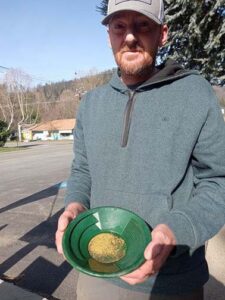


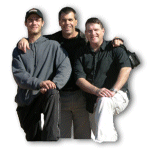
 Story by Eric Spitler
Story by Eric Spitler
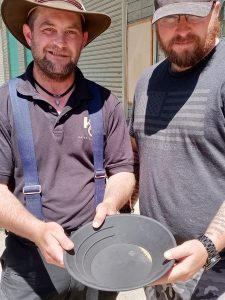



 Several years ago, Dennis lost a pretty serious contest with a large boulder that ultimately broke one of his legs in six different places. After surgery put his leg back together, Dennis returned to Hawaii to do some healing. He says he was a complete invalid for at least six months. I’ll bet! The following season, Dennis returned to
Several years ago, Dennis lost a pretty serious contest with a large boulder that ultimately broke one of his legs in six different places. After surgery put his leg back together, Dennis returned to Hawaii to do some healing. He says he was a complete invalid for at least six months. I’ll bet! The following season, Dennis returned to  I paid a visit to Dennis Kim several mornings ago, because I heard that he and his mining partner, Brent, also from Hawaii, have been recovering nice gold using hand methods inside the
I paid a visit to Dennis Kim several mornings ago, because I heard that he and his mining partner, Brent, also from Hawaii, have been recovering nice gold using hand methods inside the 




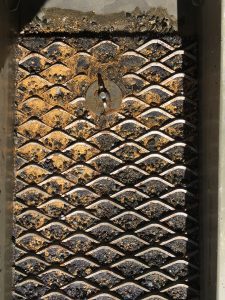 Story and images by Betsy Anderson & Eric Spitler
Story and images by Betsy Anderson & Eric Spitler 

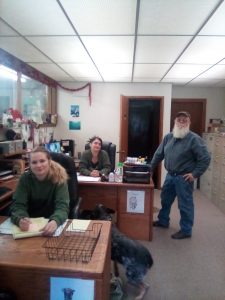

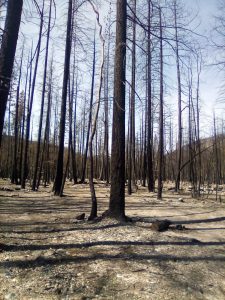



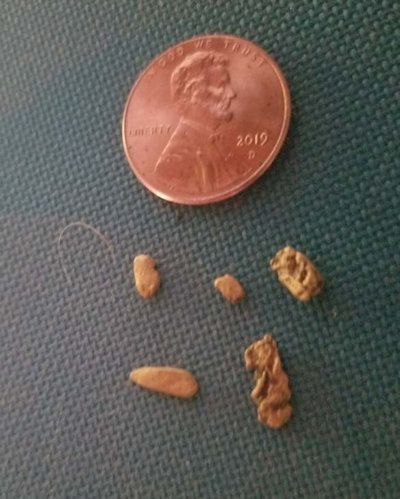

 I am very saddened to announce that Montine Blevins has passed on from a long battle with Colon Cancer. She was originally diagnosed in 2015. But she stayed at her desk and on the New 49’er phone for more than three years afterwards, always insisting that she was most happy there.
I am very saddened to announce that Montine Blevins has passed on from a long battle with Colon Cancer. She was originally diagnosed in 2015. But she stayed at her desk and on the New 49’er phone for more than three years afterwards, always insisting that she was most happy there.
 There will be 26 prizes in all:
There will be 26 prizes in all:


